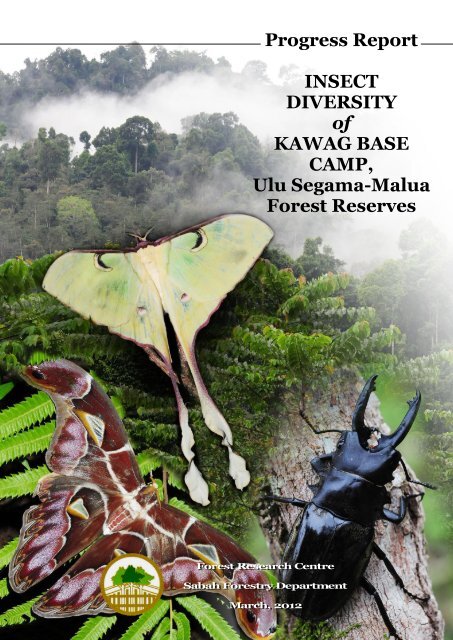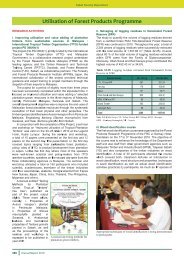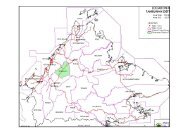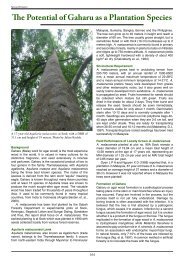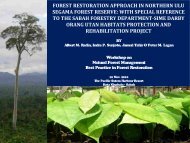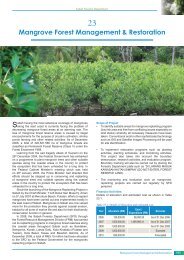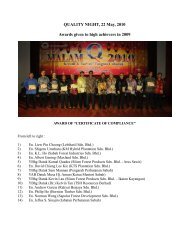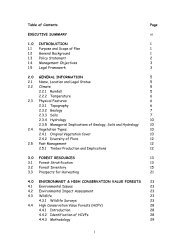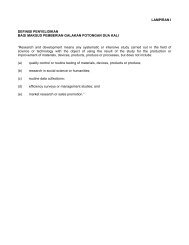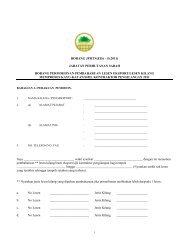Malaysia - Sabah Forestry Department
Malaysia - Sabah Forestry Department
Malaysia - Sabah Forestry Department
You also want an ePaper? Increase the reach of your titles
YUMPU automatically turns print PDFs into web optimized ePapers that Google loves.
Progress ReportINSECTDIVERSITYofKAWAG BASECAMP,Ulu Segama-MaluaForest Reserves1
CONTENTSPageSUMMARY1. STUDY AREA & PURPOSE OF STUDY2. MATERIALS & METHODS2.1 Light-trapping2.2 Insect specimens and identification3. RESULTS & DISCUSSION3.1 Nocturnal insect diversity3.2 Interesting insects at Kawag Base Camp3.2 Current issues on insect diversity &conservation at Kawag Base Camp4. CONCLUSIONACKNOWLEDGEMENTSREFERENCES3466677914161617APPENDIX 1: ButterfliesMothsBeetlesOther insects20202324Cover featuring a composite picture of the insects andvegetation found at USM FRs.Content page: A noctuid moth, Ischyja hagenii and adrepanid moth, Tridrepana subtusmaculata (top).2
INSECT DIVERSITY OF KAWAG BASE CAMP, ULU SEGAMA-MALUA FORESTRESERVES, SABAHPrincipal investigators:Assisted by:Arthur Y. C. ChungAndi Maryani A. M.Nurul Aqidah IbrahimJohn Lee YukangM.A. Tajuddin MustaphaAndi Sabrina A.M.Mustapha ChuaPetronella Dasim (preparation of report)SUMMARYAn insect diversity survey was carried out from 13 th to 17 th of February, 2012 at theKawag Base Camp within the Ulu Segama-Malua Forest Reserves (USM FRs). TheBase Camp is the centre of administration for USM FRs, covering an area of 241,089ha. This survey was conducted together with the EIA fieldwork, with the same teamreporting on wildlife mitigation and monitoring measures within USM FRs, for thepreparation of the EIA report.Among the flagship insect species recorded during the survey were the Moon Moth(Actias maenas), Atlas Moth (Archaeoattacus staudingeri) and the Stag Beetle(Odontolabis dalmani). Interesting information from insects can be incorporated topromote ecotourism when the Kawag Riverside Lodge is established in the near future.Some Bornean endemic species were also recorded, namely the Three-horned Beetle,Chalcosoma moellenkampi and four Tiger Moth species (Cyana maiae, Cyana saulia,Spilosoma hosei and Amata prepuncta). Information from insect diversity can beused to support and enhance conservation effort within USM FRs. Despite theinteresting insects recorded, the nocturnal insect diversity during the survey was low.This was partly due to the proliferation of a few flying ant species as part of theirnuptial and mating process.The various wildlife mitigation measures implemented at Kawag and throughoutUSM FRs indirectly contribute significantly to insect diversity and conservation. TheDFO of USM FRs and his staff should be commended for their pro-active action andenforcement on the wildlife monitoring programmes.Note: Some of the insect identifications are still tentative and subject to confirmation. This report willbe further improved with comments from various experts.3
1. STUDY AREA & PURPOSE OF STUDYKawag Base Camp is the centre of administration for the Ulu Segama-Malua ForestReserves (USM FRs) in Lahad Datu, <strong>Sabah</strong> (Figure 1). USM comprises six forestreserves (241,089 ha) as shown in Table 1 and Figure 2. The initial primary focus ofUSM initiative was only the Ulu Segama and Malua Forest Reserves, but later, otherforest reserves were included as they are located within / adjacent to the USM.Table 1: Forest reserves within the USM SFM project area.No. Forest Reserve Class Function Area (ha)1 Ulu Segama* II Production 202,8562 Malua II Production 33, 9693 Kawag Gibong VI Virgin Jungle Reserve 7074 Merisuli VI Virgin Jungle Reserve 5525 Sepagaya** VI Virgin Jungle Reserve 2,3166 Sapagaya I Protection 698*952 ha are outside of the USM project area**1,812 ha are outside of the USM project areaTotal 241,098The Base Camp is located at N 05 o 03.102’, E 117 o 58.856’ at about 120 m a.s.l. Thevegetation adjacent to the camp is of lowland dipterocarp forest.This survey wasconducted from 13 th to17 th of February, 2012as part of therequirement to preparethe EIA report forUSM FRs. During theEIA survey, the teamvisited various siteswithin the USM FRsto look at the variouswildlife mitigationmeasures initiated.This report, however,focuses mainly on thenocturnal insects. It isan unpublished reportFigure 1: Location of USM FRs in <strong>Sabah</strong>.for record purposes only, highlighting some of the interesting insects recorded fromKawag and some points of discussion on insect diversity and conservation.4
Kawag Base CampFigure 2: Forest reserves within the USM FRs project area.5
2. MATERIALS & METHODS2.1 Light-trappingLight trap was used to sample nocturnal insects. The trap consists of a vertical whitesheet (2 X 2 m) illuminated by a 250W mercury-lithium bulb. The trap was set up inan open area facing the forest reserve, from 7:00 to 9:00 p.m. A GPS (Model: GarminGPSMAP 60CSx) was used to determine the coordinates of each sampling site.Temperature and humidity were taken with a digital gadget from Oregon Scientific(model no. ETHG-912).To evaluate diversity of the sampling area, insect species and individuals (≥ 5 mm)within the 1 X 1 m square of the white cloth were enumerated from 8:30 to 9:00 pm.This is a rapid biodiversity assessment method because by the end of the samplingtime, species and individual numbers can be obtained, and the data can be used tocalculate diversity indices, i.e. Shannon Wiener, Simpson and Fisher Alpha, using theSpecies Diversity & Richness version IV (SDR 2006). This method is simple, fast andcan be carried out by non-insect specialist. To avoid compounding human error, thesame staff was assigned to count the species and individual numbers throughout thesampling period, and also for other sampling sites. Light-trapping sites are shown inTable 2.Table 2: Light-trapping sites at Kawag Base Camp, USM FRs.Sampling site Coordinates Elevation(m)A1 N 05 o 03.066’(Kawag riverside E 117 o 58.278’area)A2(Kawag BaseCamp entrance)A3(Ali Baba trail)N 05 o 03.006’E 117 o 58.846’N 05 o 02.930’E 117 o 58.880’2.2 Insect specimens and identificationTemp.( o C)Humidity(%)SamplingdateRemarks91 26 87 13 Feb Fine weatherwithout moon114 24 89 14 Feb Fine weatherwithout moon100 25 91 15 Feb Fine weatherwithout moonIn this survey, focus was given to nocturnal insects only. Photographs were taken witha DSLR Nikon D300 and a compact Nikon Coolpix to facilitate identification. Onlyselected insects were sampled but photographs of most insects sighted were taken forrecord purposes.Specimens and photographs were identified based on the FRC Entomology Collectionand various reference materials, e.g. Otsuka (1988 & 2001) and Corbet & Pendlebury(1992) for butterflies; Holloway (1983, 1985, 1986, 1988, 1989, 1993, 1996a, 1997,1998a & b, 1999, 2001, 2003, 2005, 2008, 2009 & 2011) and Robinson et al. (1994)for moths; Fujita (2010), Makihara (1999) and Tung (1983) for beetles.6
3. RESULTS & DISCUSSION3.1 Nocturnal insect diversityThe nocturnal insect diversity at the Kawag Base Camp during the sampling periodwas relatively low compared to other forest reserves as indicated in Table 3. Being afairly good logged over forest, it was expected to yield much better diversity results.Moreover, various species of interesting insects, especially macro moths were seenattracted to the lights within the Kawag resthouse, staff quarters and office at night.The low nocturnal insect diversity duringthe sampling period was partly due to theproliferation of a few hymenopteran species,especially flying ants (Figure 3). It was partof the nuptial flight and mating process ofthe ants. It is not uncommon for one colonyto release hundreds or thousands of youngwinged males and queens at any one time.Many are attracted to the light. The highabundance of the ant species is reflected inthe species-rank abundance curves inFigure 4, especially at Site A1 and A3.Figure 3: The mating process of aPolyrhachis ant species during lighttrapping.Table 3: Insect diversity within a one-square-metre, as sampled through lighttrappingat Kawag Base Camp, USM FRs (Sites A1, A2 & A3) compared to selectedsites of Rafflesia, Milian Labau, Bukit Hampuan and Gn. Lumaku F.Rs.No. Sampling site Species Ind. Shannon Simpson Fisher Alpha1 A1 75 139 3.56 12.31 66.442 A2 51 63 3.83 102.80 124.803 A3 55 97 3.16 7.68 52.654 Rafflesia(Site B)5 Milian Labau(Site 1)6 BukitHampuan(Site 2)7 Gn. Lumaku(southern part -Site 5)61 67 4.06 245.67 330.0679 122 4.05 45.56 97.03119 142 4.61 111.23 346.35124 163 4.56 90.43 236.607
1815222936435057647178Logabundance32.521.510.50Species rankSiteFigure 4: Species-rank abundance curves of the light-trapping sites at Kawag BaseCamp.During light-trapping at Kawag, a few Bornean endemic insect species were recorded,as listed in Table 4, namely the locally common Three-horned Beetle and four mothspecies of the family Arctiidae, commonly known as Tiger Moths.Table 4: Bornean endemic insect species recorded at Kawag Base Camp duringthe survey.No. Species Order Family Subfamily1 Chalcosoma moellenkampi Coleoptera Scarabaeidae Dynastinae2 Spilosoma hosei Lepidoptera Arctiidae Arctiinae3 Amata prepuncta Lepidoptera Arctiidae Lithosiinae4 Cyana maiae Lepidoptera Arctiidae Lithosiinae5 Cyana saulia Lepidoptera Arctiidae Lithosiinae8
Cyana maiae Spilosoma hosei Amata prepunctaChalcosoma moellenkampiCyana sauliaFigure 5: Endemic insects recorded from Kawag Base Camp, USM FRs(13-17 February, 2012).3.2 Interesting insects at Kawag Base CampAlthough the nocturnal insect diversity was relatively low during the sampling period,many interesting insects, especially moths, were recorded. These include the MoonMoth, Actias maenas and the Atlas Moth, Archaeoattacus staudingeri which aregiants among the insects. Other large interesting moths recorded were Eupterotenaessigi, Eupterote asclepiades, Ambulyx pryeri and Antheraea jana.Actias maenas is one of the two spectacular Moon Moth species found in Borneo.Although it is widely distributed in South-east Asia, it is infrequently encountered andhas been recorded only from the lowland forest (Holloway 1987). It is, however,known to be fairly common at Kawag Base Camp (Saiful Majid, pers. comm.).9
Among the moths, this species has the longest and most graceful pair of trailing tails.This striking moth has a wing span of about 14 cm and a body length of about 7 cm.The mimic ‘eye’ that forms a cresent on the forewing is believed to be a defencestrategy to frighten its intruder. Like many other saturniids, this large and beautifulmoth does not feed. It will live for about 7-10 days.Figure 6: Actias maenas (female).Figure 7: Actias maenas (male)(Photo: Robert Mijol).Figure 8: Archaeoattacus staudingeri.Archaeoattacus staudingeri is one of the Atlas Moth species recorded at Kawagduring the sampling period. This species has a deeper purplish brown compared to themore common Attacus atlas. It is distributed throughout the Sundaland but there is noinformation on its life history and not much is known on its hostplants (Holloway10
1987, Robinson et al. 2001). Interestingly, two specimens were recorded throughoutthe three night sampling at Kawag. Atlas Moths are considered the largest moths inthe world in terms of total wing surface area [upwards of c. 400 cm 2 (62 sq in)]. Theirwing spans are also among the largest, reaching over 25 cm (10 in). Females areappreciably larger and heavier. Atlas Moths are said to be named after either the Titanof Greek mythology, or their map-like wing patterns. In Hong Kong, the Cantonesename translates as "snake's head moth", referring to apical extension of the forewing,which bears a passing resemblance to a snake's head (Wikipedia 2011).Besides the night winged beauties, variousbutterfly species are expected to be found withinthe Kawag Base Camp although no effort wasemployed to sample butterflies in this survey. TheTree Nymph, Idea stolli was sighted more thanfour times at Kawag. It is a large butterfly with awing span of about 15 cm, often seen flyinggracefully in pairs at the fringe of the forest.Figure 9: Idea stolli.Although the Rajah Brooke’s Birdwing (Troides(Trogonoptera) brookiana) and other Birdwings(Troides spp.) were not sighted during the survey, they are expected to be found in thelowland forest of Kawag. Both are protected species under the Wildlife ConservationEnactment 1997.Among the large beetles sampled at Kawagwere the Three-horned Beetle, Chalcosomamoellenkampi and Stag Beetle, Odontolabisdalmani. The Three-horned Beetle is among thelargest beetles in <strong>Malaysia</strong>. Although it isconfined to Borneo, it is a locally commonbeetle. The male Stag Beetle of O. dalmani,measuring about 65 mm has a pair of hardmandibles, about 12 mm in length. BesidesBorneo, it is also found in Peninsular <strong>Malaysia</strong>,Sumatra and Java.It is also noteworthy to mention the presence of‘fire ants’ at Kawag Base Camp. The ants arefrom the subfamily Ponerinae, identified as Figure 10: Odontolabis dalmani.Leptogenys processionalis. They forage incolony of hundreds or thousands, and mostly active at night. It is an irritating speciesbecause they bite and sting any intruders which pass or step on their swarming trails,as we have experienced during light-trapping. The ants swarmed the light-trappingground in search for insects dropped onto the ground.Other butterflies, moths, beetles and insects of other groups recorded during the EIAsurvey at USM FRs are listed in Appendix 1. Some moths and beetles are showcasedin Figures 11 and 12 respectively.11
Figure 11: Selected moth species (not to scale) attracted to the light at Kawag Base Camp (13-17 Feb., 2012): 1.Erebus ephesperis (Noctuidae); 2. Antheraea jana (Saturniidae); 3.Tridrepana subtusmaculata (Drepanidae); 4.Ornithospila cincta (Geometridae); 5. Ugia viridior (Noctuidae); 6. Tridrepana microcrocea (Drepanidae); 7.Phyllodes eyndhovii (Noctuidae); 8. Chorodna complicataria (Geometridae); 9. Bastilla fulvotaenia (Noctuidae); 10.Parasynegia sundastriaria (Geometridae); 11. Lyssa menoetius (Uraniidae); 12. Eupterote asclepiades(Eupterotidae); 13. Rhimphalea astrigalis (Pyralidae); 14. Suana sundana (Lasiocampidae); 15. Ambulyx pryeri(Sphingidae); 16. Agrioglypta naralis (Pyralidae); 17. Unidentified (Pyralidae); 18. Cechenena helops (Sphingidae);19. Episparis costistriga (Noctuidae); 20. Nygmia guttulata (Lymantriidae).12
Lepidiota stigma(Scarabaeidae)Rhytidodera sp.(Cerambycidae)Alaus sp.(Elateridae)Cyclommatus canaliculatus(Lucanidae)Aceraius sp.(Passalidae)Cosmodela aurulenta(Cicindelidae)?Eulichas sp.(Eulichadidae)Phyllophaga sp.(Scarabaeidae)Xoanodera vitticollis(Cerambycidae)Figure 12: Selected beetles recorded from Kawag Base Camp (13-17 Feb., 2012).13
3.3 Current issues on insect diversity and conservation at Kawag Base CampWithin the USM FRs, various wildlife mitigation measures have been initiated andimplemented to conserve and protect wildlife, such as prohibition of hunting,establishment of checking stations and other wildlife monitoring programmes. Allthese are presented in the USM FRs EIA Report (2012, in preparation), whichindirectly contribute positively towards insect diversity and conservation.Checking station and gate.Warning signages.Artificial saltlick.Camera trap.Figure 13: Some of the wildlife mitigation measures implemented at USM FRs.The presence of various interestinglarge insect species, such as the MoonMoth and Atlas Moth, can be used topromote ecotourism at Kawag. Theelegant Moon moth is considered rare atmany places in <strong>Sabah</strong> but it has beencommonly sighted at Kawag. Theestablishment of the Kawag RiversideLodge in the near future can incorporateFigure 14: Eupterote naessigi is one of fascinating insects as a tourismthe more striking moths.attraction for special interest tourists.As done in 2009, the Entomology Section of FRC has curated and put up some insectson display at the Kawag office and resthouse. The Lodge which is to be built adjacentto the Kawag River is also ideal as a habitat for various lowland forest butterflyspecies.14
Figure 15: Kawag River is a suitable habitat for some lowland butterflies(Photo: Jarry Lajanga).Figure 16: The orangey-red street light at theKawag Base Camp.Nocturnal insects are highlysensitive towards ultravioletlight (Anon. 2009). Hence, itmay adversely affect the ecologyand population of insects fromthe adjacent forest. The streetlights within the Kawag BaseCamp are orangey-red in colour(infrared), and thus do not causemuch adverse effect to thenocturnal insects and otherwildlife attracted to light. Suchinfrared light (with lowultraviolet ray) should continueto be used so that it will poseless effect on the insectassemblages from the adjacentforest. White inflorescent lights(high in ultraviolet ray) installedat the verandah or porch at theresthouse and staff quartersattracted many insect species which can be disturbing and irritating. Moreover, thepresence of too many insects may dirty the premises.15
4. CONCLUSIONFrom the survey and interview with <strong>Forestry</strong> staff of USM FRs, many interestinginsects were sighted at the Kawag Base Camp despite the low diversity during thelight-trapping period. Large fascinating moths, such as the Moon Moth and AtlasMoth were recorded and they are known to be fairly common at the Kawag BaseCamp, attracted to the light at night. These insects can be used to support and promotenature tourism, especially when the Kawag Riverside Lodge is established. Thevarious wildlife mitigation measures implemented at Kawag and throughout USMFRs indirectly contribute significantly to insect diversity and conservation. The DFOof USM FRs and his staff should be commended for their pro-active action andenforcement on the wildlife monitoring programmes.ACKNOWLEDGEMENTSWe thank the DFO of USM FRs (Indra P. Sunjoto) and his staff for logistics supportand information during the EIA survey. The survey coordinators, Dr Reuben Nilus,Dr Joan Pereira and Suzana Sabran are acknowledged for the arrangement of thesurvey. Various other sections (Entomology, Botany, Ecology, Ecotourism, Soil &Phytochemistry) of FRC also contributed indirectly in this survey. The FRM Division(Rosila Anthony) and Jumri Abd. Hamid of FRC provided the maps. The DeputyDirector (R&D), Dr Lee Ying Fah and Head of FRC Insect Diversity Programme, DrChey Vun Khen are also acknowledged for their support.16
REFERENCESAnon. (2009). Artificial light in the environment. The Royal Commission onEnvironmental Pollution, UK.Fujita, H. (2010). The lucanid beetles of the world. Mushi-Sha’s Iconographic Seriesof Insects 6, Tokyo, Japan.Holloway, J.D. (1983). Moths of Borneo (part 4): family Notodontidae. MalayanNature Journal 37: 1-107.Holloway, J.D. (1985). Moths of Borneo (part 14): Family Noctuidae: subfamiliesEuteliinae, Stictopterinae, Plusiinae, Pantheinae Malayan Nature Journal 38: 157-317.Holloway, J.D. (1986). Moths of Borneo (part 1): key to families: families Cossidae,Metarbelidae, Ratardidae, Dudgeoneidae, Epipyropidae and Limacodidae. MalayanNature Journal 40: 1-166.Holloway, J.D. (1988). The moths of Borneo (part 6): family Arctiidae, subfamiliesSyntominae, Euchromiinae, Arctiinae; Noctuidae misplaced in Arctiidae(Camptoloma, Aganainae). Southdene Sdn. Bhd., Kuala Lumpur. 101 pp.Holloway, J.D. (1989). The moths of Borneo (part 12): family Noctuidae, trifinesubfamilies: Noctuinae, Heliothinae, Hadeninae, Acronictinae, Amphipyrinae,Agaristinae. Southdene Sdn. Bhd., Kuala Lumpur. 226 pp.Holloway, J.D. (1993). The moths of Borneo (part 11): family Geometridae, subfamilyEnnominae. Southdene Sdn. Bhd., Kuala Lumpur. 309 pp.Holloway, J.D. (1996). The moths of Borneo (part 9): family Geometridae,subfamilies Oenochrominae, Desmobathrinae and Geometrinae. Malayan NatureJournal 49: 147-326.Holloway, J.D. (1997). The moths of Borneo (part 10): family Geometridae,subfamilies Sterrhinae & Larentiinae. Malayan Nature Journal 51: 1-242.Holloway, J.D. (1998a). The moths of Borneo (part 8): families Castniidae,Callidulidae, Drepanidae & Uraniidae. Malayan Nature Journal 52: 1-155.Holloway, J.D. (1998b). The moths of Borneo (part 3): superfamily Bombycoidea:families Lasiocampidae, Eupterotidae, Bombycidae, Brahmaeidae, Saturniidae,Sphingidae. Southdene Sdn. Bhd., Kuala Lumpur. 199 pp.Holloway, J.D. (1999). The moths of Borneo (part 5): family Lymantriidae. MalayanNature Journal 53: 1-188.17
Holloway, J.D. (2001). The moths of Borneo (part 7): family Arctiidae, subfamilyLithosiinae. Southdene Sdn. Bhd., Kuala Lumpur. 486 pp.Holloway, J.D. (2003). The moths of Borneo (part 18): family Nolidae. SouthdeneSdn. Bhd., Kuala Lumpur. 279 pp.Holloway, J.D. (2005). The moths of Borneo: family Noctuidae, subfamilyCatocalinae. Malayan Nature Journal 58(1-4): 1-529.Holloway, J.D. (2008). The moths of Borneo: family Noctuidae, subfamiliesRivulinae, Phytometrinae, Herminiinae, Hypeninae and Hypenodinae. MalayanNature Journal 60(1-4): 1-268.Holloway, J.D. (2009). The moths of Borneo (part 13): family Noctuidae, subfamilyPantheinae (part), Bagisarinae, Acontiinae, Aediinae, Eustrotiinae, Bryophilinae,Araeopteroninae, Aventiinae, Eublemminae and further miscellaneous genera.Malayan Nature Journal 62(1&2): 1-240.Holloway, J.D. (2011). The moths of Borneo: families Phaudidae, Himantopteridaeand Zygaenidae; revised and annotated checklist. Malayan Nature Journal 63(1-2): 1-548.Makihara, H. (1999). Atlas of longicorn beetles in Bukit Soeharto Education Forest,Mulawarman University, East Kalimantan, Indonesia. PUSREHUT SpecialPublication No. 7. Mulawarman University & JICA. 140 pp.Otsuka, K. (1988). Butterflies of Borneo. Vol. I. Tobishima Corporation, Tokyo,Japan. 61 pp.Otsuka, K. (2001). A field guide to the butterflies of Borneo and South East Asia.Hornbill Books. 224 pp.Robinson, G.S., Tuck, K.R. & Shaffer, M. (1994). A field guide to smaller moths ofSouth-east Asia. The Natural History Museum, London & <strong>Malaysia</strong>n Nature Society.309 pp.SDR (2006). Species Diversity & Richness version IV. Pisces Conservation Ltd.,Lymington, UK.Tang, H.B., Wang, L.K. & Hamalainen, M. (2010). A photographic guide to thedragonflies of Singapore. The Raffles Museum of Biodiversity Research, Singapore.222 pp.Tung, V. W-Y. (1983). Common <strong>Malaysia</strong>n beetles. Longman, Kuala Lumpur. 142 pp.Wikipedia (2011). http://en.wikipedia.org/wiki/Attacus_atlas18
APPENDIX 119
Appendix 1: Insects recorded from Ulu Segama-Malua FRs from 13-17 February, 2012.Butterflies (Lepidoptera)No. Species Author Family Remarks / Photo1 Eurema sp. Pieridae Spotted2 Papilio nephelus albolineatus Forbes Papilionidae Spotted3 Troides brookiana brookiana Wallace Papilionidae Spotted at Silam (Protected, WCE 1997)4 Troides sp. Papilionidae Spotted at SBE, Malua (Protected, WCE1997)5 Amathusia phidippus phidippus Linnaeus Nymphalidae USM31376 Anosia genutia intensa Moore Nymphalidae USM3059, 3063, 30657 Cethosia hypsea hypsea Doubleday Nymphalidae Spotted8 Idea stolli virgo Fruhstorfer Nymphalidae Abundant at Kawag9 Neptis sp. Fruhstorfer Nymphalidae Spotted10 Ypthima sp. Hewitson Nymphalidae SpottedMoths (Lepidoptera)No. Species Author Family SubfamilyPhoto no.(USM)Remarks1 Cyana conclusa Walker Arctiidae Arctiinae 30082 Oenistis altica Linnaeus Arctiidae Arctiinae 27713 Spilosoma hosei Rothschild Arctiidae Arctiinae 2970 Endemic to Borneo4 Adites sp. Arctiidae Lithosiinae 2899a5 Amata prepuncta Holloway Arctiidae Lithosiinae 2776 Endemic to Borneo6 Cyana maiae Holloway Arctiidae Lithosiinae 2882/2796 Endemic to Borneo7 Cyana saulia Swinhoe Arctiidae Lithosiinae 2992 Endemic to Borneo20
No. Species Author Family SubfamilyPhoto no.(USM)Remarks8 Nyctemera muelleri Vollenhoven Arctiidae Lithosiinae 30099 "Barsine" porphyrea Snellen Arctiidae Syntominae 277410 Amerila sp. Arctiidae Arctiinae 276811 Creatonotos transiens Walker Arctiidae Arctiinae 297712 Gunda ochracea Walker Bombycidae 276713 Xyleutes ceramica Walker Cossidae spotted14 Xyleutes mineus Cramer Cossidae 277915 Xyleutes strix Linnaeus Cossidae 274416 Zeuzera indica Herrich-Schaffer Cossidae 300717 Tridrepana microcrocea Gaede Drepanidae Drepaninae 297818 Tridrepana subtusmaculata Gaede Drepanidae Drepaninae 291119 Eupterote asclepiades Felder Eupterotidae 280820 Eupterote naessigi Holloway Eupterotidae 281021 Amblychia hymenaria Guenee Geometridae Ennominae 296722 Biston insularis Warren Geometridae Ennominae 312923 Bracca maculosa Walker Geometridae Ennominae 292024 Celenna centraria Snellen Geometridae Ennominae 274725 Chorodna complicataria Walker Geometridae Ennominae 290226 Comostola sp. Geometridae Ennominae 297627 Hypochrosis pyrrhophaeata Walker Geometridae Ennominae 298828 Parasynegia sundastriaria Holloway Geometridae Ennominae 288729 Zamarada sp. Geometridae Ennominae 291930 Ornithospila cincta Walker Geometridae Geometrinae 299131 Ornithospila sundaensis Holloway Geometridae Geometrinae 296832 Pingasa rubicunda Warren Geometridae Geometrinae 274633 Tanaorhinus rafflesii Moore Geometridae Geometrinae 276421
No. Species Author Family SubfamilyPhoto no.(USM)Remarks34 Thalassodes linguissita Holloway Geometridae Geometrinae 297935 Celerena signata Warren Geometridae Oenochrominae 275936 Suana sundana Holloway Lasiocampidae 290437 Psilochira venusta Collenette Lymantriidae 291038 Nygmia guttulata Snellen Lymantriidae 290039 Asota heliconia Linnaeus Noctuidae Aganainae 277740 "Saroba" maculicosta Walker Noctuidae Catocalinae 278041 Bastilla fulvotaenia Guenee Noctuidae Catocalinae 297542 Bastilla sp. Noctuidae Catocalinae 276043 Buzara onelia Guenee Noctuidae Catocalinae 288444 Episparis costistriga Walker Noctuidae Catocalinae 289745 Erebus ephesperis Hubner Noctuidae Catocalinae 276246 Eudocima (Rhytia) cocalus Cramer Noctuidae Catocalinae 289947 Ischyja hagenii Snellen Noctuidae Catocalinae 299848 Mimeusemia postica Walker Noctuidae Catocalinae 299349 Phyllodes eyndhovii Vollenhoven Noctuidae Catocalinae 290150 Ugia viridior Holloway Noctuidae Catocalinae 3135 & 300151 Blenina sp. Nolidae 301552 Agrioglypta naralis Felder & Pyralidae Pyraustinae 2994Rogenhofer53 Heterocnephes lymphatalis Swinhoe Pyralidae Pyraustinae 287154 Pycnarmon sp. Pyralidae Pyraustinae 277355 Rhimphalea astrigalis Hampson Pyralidae Pyraustinae 299056 Sisyrophora pfeifferae Lederer Pyralidae Pyraustinae 301757 Syllepte fabiusalis Walker Pyralidae Pyraustinae 300658 Unidentified Pyralidae 298922
No. Species Author Family SubfamilyPhoto no.(USM)Remarks59 Unidentified Pyralidae 300560 Actias maenas Doubleday Saturniidae 275361 Antheraea jana Stoll Saturniidae 314162 Archaeoattacus staudingeri Rothschild Saturniidae 298463 Ambulyx canescens Walker Sphingidae 290564 Ambulyx pryeri Distant Sphingidae 279565 Cechenena helops Walker Sphingidae 287266 Elibia dolichus Westwood Sphingidae 276367 Marumba juvencus Rothschild & Sphingidae 3023Jordan68 Urapteroides astheniata Guenee Uraniidae Microniinae 280469 Lyssa menoetius Hopffer Uraniidae Uraniinae 3025Beetles (Coleoptera)No. Species Author Family Photo no. (USM)1 Aeolesthes sp. Cerambycidae 27912 Batocera thomsoni Javet Cerambycidae 30213 Rhytidodera sp. Cerambycidae 31174 Xoanodera vitticollis Gahan Cerambycidae 31095 Cosmodela aurulenta Fabricius Cicindelidae 28926 Alaus sp. Elateridae 27837 ?Eulichas sp. Eulichadidae 29668 Cyclommatus canaliculatus Ritsema Lucanidae 28709 Odontolabis dalmanni Hope et Westwood Lucanidae 295923
No. Species Author Family Photo no. (USM)10 Aceraius sp. Passalidae 299611 Anomala pallida (Fabricius) Scarabaeidae 289412 Anomala sp. Scarabaeidae 276913 Chalcosoma moellenkampi Kolbe Scarabaeidae 276514 Exopholis hypoleuca Wiedemann Scarabaeidae 312615 Lepidiota stigma (Fabricius) Scarabaeidae 288816 Oryctes sp. Linnaeus Scarabaeidae 291617 Phyllophaga sp. Scarabaeidae 2964Other insectsNo. Species Author Order Family RemarksPhoto no.(USM)1 Dundubia vaginata Fabricius Hemiptera Cicadidae Green Cicada spotted2 Orientopsaltria sp. Hemiptera Cicadidae Cicada 30243 Platylomia sp. Hemiptera Cicadidae Cicada 29094 Pomponia merula Distant Hemiptera Cicadidae Giant Cicada 20855 Camponotus gigas (Latreille) Hymenoptera Formicidae Giant Forest Ant spotted6 Leptogenys processionalis Emery Hymenoptera Formicidae Fire Ant spotted7 Provespa anomala Saussure Hymenoptera Vespidae Night Wasp spotted8 Deroplatys dessicata Beier Dictyoptera Mantidae Praying Mantis spotted9 Mecopoda elongata (Linnaeus) Orthoptera Tettigoniidae Giant Bush Cricket spotted24


